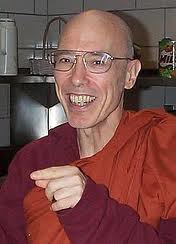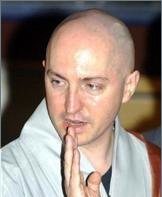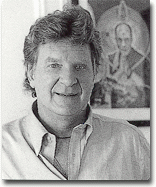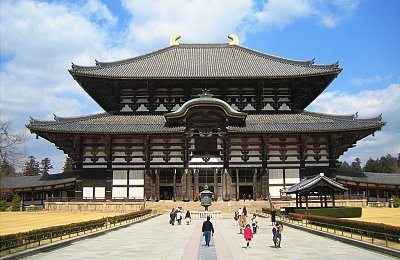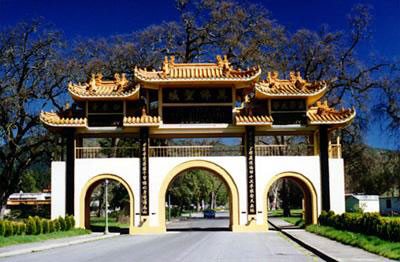Sotapanna is the Pali word for stream entry. We enter the stream by lessening the first three fetters of the ten fetters, i. e., the fetters of 1) sakkaya ditthi, the belief that we are an independent self, i. e., that a self can be found in the five aggregates, 2) doubt about the Buddha and his teachings, and 3) the belief that rites and rituals lead to enlightenment. A stream enterer has at most seven lifetimes before full awakening occurs.
Zen can be a meditation practice and nothing more. However, adding the practice of chanting to our collection of practices helps us broaden our practice. And there are a number of other practices as well that help us maintain our practice as the years go by.
Prostration Practice
Let’s consider a prostration practice. It’s a practice that needs to be built up gradually over time and not rushed into. We recommend starting with nine prostrations per day and working up to the larger numbers as the counting technique is learned. The counting technique does not involve counting the prostrations with numbers. Simply counting a prostration is a waste. There are no external entities to whom we bow. There is no “out there,” no mind and body within, no world without. Roshi Yasutani called prostrations “the horizontalizing of the mast of ego.” We bow to our inherent Buddha nature, which is, in the words of the Ten Verse Kanzeon chant, eternal, joyous, selfless, pure. 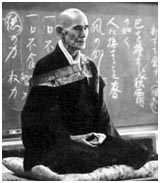
(1885-1973)
We begin standing erect, facing a Buddha statue if available, or just empty space if we prefer. We can use a yoga or pilates mat, or just a towel on a carpet. 1. We squat down and place our hands in front of us, preferably one hand at a time, and then rock forward so that our knees are on the floor. Our left hand is on the mat in front of our left knee and our right hand is on the mat in front of our right knee, palms down. Our hands may be further apart than our knees and our hands may be just a few inches in front of our knees. 2. We lift our feet so that our toes can lie flat with the top surface of the toes overlying the floor. 3. We bend our elbows and lower our head to the floor or mat, touching our forehead. 4. With our neck muscles now supporting our torso, we lift our hands, move them forward, turn the palms up and shift the torso weight back to our arms. We lift both palms together about six inches or so, hold them there for a moment, and return them to the floor, still palms up, pausing a moment just above the floor before putting them down. We may visualize when lifting the hands that we are lifting the Buddha or the Buddhadharma (the teachings of the Buddha). 5. Then we turn both palms back to the floor, lift our feet so that the bottom surface of the toes once again overlie the floor, and return to a standing posture. The Chinese version differs from the Japanese version just described in that instead of lifting the hands when the palms are turned up, the hands remain down, the fingers are closed to form a fist, re-opened, and then the hands are turned palms down for returning to the standing posture. Flexible people can drop to their knees before placing their hands in front of them, and they can rock back to a standing position after completing the prostration without using their hands to push up from the floor. Here is a short YouTube video of someone I don’t know demonstrating three prostrations. I have always wanted to say “Thank You” to that fellow for his excellent demonstration. He performs each prostration quickly but we can and should go more slowly. We want to be mindful of each prostration. Prostrations may seem at first glance to have religious overtones. However, nothing in Buddhism is religious because there is no Great Entity out there to whom we must re-connect. Religious people tell their god or savior that they are sorry for not believing in them earlier, or not following their teachings earlier. Taking refuge in the Buddha, the Dharma, and the Sangha, on the other hand, recognizes that there is no independent entity outside ourselves that we can say “I’m sorry” to. .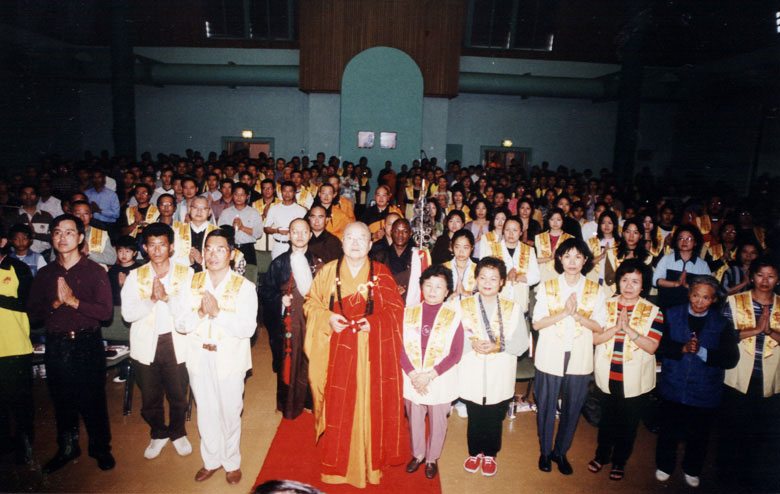
Taking Refuge with Master Hsing Yun
(founder of Fo Guang Shan, Buddha Light Mountain)
With the first prostration, we inwardly recite: I take refuge in the Buddha and resolve that with all beings I will understand the Great Way whereby the Buddha seed may forever thrive. With the second prostration, we inwardly recite: I take refuge in the Dharma and resolve that with all beings I will enter deeply into the sutra treasure whereby my wisdom may grow as vast as the ocean. With the third prostration, we inwardly recite: I take refuge in the Sangha and in its wisdom, example, and never failing help, and resolve to live in harmony with all sentient beings. With the fourth prostration, we inwardly recite: For the second time, I take refuge in the Buddha and resolve that with all beings I will understand the Great Way whereby the Buddha seed may forever thrive. With the fifth prostration, we inwardly recite: For the second time, I take refuge in the Dharma and resolve that with all beings I will enter deeply into the sutra treasure whereby my wisdom may grow as vast as the ocean. With the sixth prostration, we inwardly recite: For the second time, I take refuge in the Sangha and in its wisdom, example, and never failing help, and resolve to live in harmony with all sentient beings. With the seventh prostration, we inwardly recite: For the third time, I take refuge in the Buddha and resolve that with all beings I will understand the Great Way whereby the Buddha seed may forever thrive. With the eighth prostration, we inwardly recite: For the third time, I take refuge in the Dharma and resolve that with all beings I will enter deeply into the sutra treasure whereby my wisdom may grow as vast as the ocean. With the ninth prostration, we inwardly recite: For the third time, I take refuge in the Sangha and in its wisdom, example, and never failing help, and resolve to live in harmony with all sentient beings. Obviously, these nine prostrations are simply taking refuge in the Buddha, Dharma and Sangha three times. This is the traditional way of taking refuge. After we are used to nine prostrations and have memorized the Taking Refuge chants, we can gradually do more prostrations. To increase our daily prostration practice from nine to twelve, we recite the Three General Resolutions that we learned in beginning Zen. With the tenth prostration, we inwardly recite: I resolve to avoid evil. With the eleventh prostration, we inwardly recite: I resolve to do good. With the twelfth prostration, we inwardly recite: I resolve to liberate all sentient beings. When we feel that we are physically fit enough to double our prostrations from twelve to twenty four, we add recitation of the Four Noble Truths (ariya sacca), and the Eightfold Path (ariyo atthangiko maggo), also known as the path leading to cessation/nirodha of suffering/dukkha, or dukkha nirodha gamini patipada. With the thirteenth prostration, we inwardly recite: All compounded things are unsatisfactory/dukkha. With the fourteenth prostration, we inwardly recite: Craving, tanha, conditioned by ignorance/avijja, is dukkha samudaya, the origin of dukkha. With the fifteenth prostration, we inwardly recite: Dukkha can be brought to cessation, dukkha nirodha. With the sixteenth prostration, we inwardly recite: The eightfold path, ariyo atthangiko maggo, is the path to cessation of dukkha. With the seventeenth prostration, we inwardly recite: Right understanding, samma ditthi, is the first fold. With the eighteenth prostration, we inwardly recite: Right thought, samma sankappa, is the second fold. With the nineteenth prostration, we inwardly recite: Right speech, samma vacha, is the third fold. With the twentieth prostration, we inwardly recite: Right action, samma kammanta, is the fourth fold. With the twenty first prostration, we inwardly recite: Right livelihood, samma ajiva, is the fifth fold. With the twenty second prostration, we inwardly recite: Right effort, samma vayama, is the sixth fold. With the twenty third prostration, we inwardly recite: Right mindfulness, samma sati, is the seventh fold. With the twenty fourth prostration, we inwardly recite: Right concentration, samma samadhi, is the eighth fold. When we want to do more than twenty four prostrations each day, we recite the Repentance Gatha three times to bring our total to twenty seven. With the twenty fifth prostration, we inwardly recite: All evil deeds committed by me since time immemorial, stemming from greed, anger and delusion, arising from body, speech and mind, I now repent having committed. With the twenty sixth prostration, we inwardly recite: For a second time, all evil deeds committed by me since time immemorial, stemming from greed, anger and delusion, arising from body, speech and mind, I now repent having committed. With the twenty seventh prostration, we inwardly recite: For a third time, all evil deeds committed by me since time immemorial, stemming from greed, anger and delusion, arising from body, speech and mind, I now repent having committed. We can substitute “ignorance” for “delusion” if we prefer. These twenty seven recitals are easily remembered. The first nine are simply taking refuge for a first, second and third time, a very common practice. We then recite the three general resolutions to get to twelve prostrations, followed by the four noble truths, the eightfold path, and three recitations of the repentance gatha. The alternative is to count twenty seven prostrations. However, by incorporating these silent recitations into prostration practice, we avoid counting and the prostrations become less of a physical exercise and more of a Buddhist practice. We can also build up to twenty seven prostrations gradually. We can do three daily until we are ready for six, and so on. Twenty seven is one-quarter of the way to the traditional number of one hundred eight. By repeating the above recitations every day, they become second nature, i.e., part of us. 
To complete a second set of twenty seven, we recite the Ten Cardinal Precepts in order to complete thirty seven prostrations. Then we recite the twelve Nidanas (the twelve steps of Dependent Origination) to arrive at forty nine prostrations. We then recite the five hindrances to arrive at the total of fifty four (half-way to the traditional number of one hundred eight). The Pali term for Dependent Origination is pratityasamupada. Thus, with prostration number thirty eight we recite: (choose either of Pali/Sanskrit) The arising of ignorance (avijja/avidya) leads to volition. (Avijja paccaya sankhara) The next eleven recitations (of course you can re-word these as you like) are: The arising of volition (sankhara/samskara) leads to consciousness. (Sankhara paccaya vinnanam) The arising of consciousness (vinnana/vijnana) leads to name and form. (Vinnana paccaya namarupam) The arising of name and form (nama-rupa) leads to the six sense organs. (Nama-rupa paccaya salayatanam) The arising of the six sense organs (the five senses plus the mind) (salayatana/shadayatana) leads to contact. (Salayatana paccaya phasso) The arising of contact (phassa/sparsha) leads to feeling. (Phasso paccayam vedana) The arising of feeling (vedana/vedana) leads to craving. (Vedana paccaya tanha) The arising of craving (tanha/trishna) leads to clinging. (Tanha paccaya upadanam) The arising of clinging (upadana/upadana) leads to becoming. (Upadana paccaya bhava) The arising of becoming (bhava/bjava) leads to birth. (Bhava paccaya jati) The arising of birth (jati/jati) leads to old age, sickness, and death. (Jati paccaya jara-maranam) This completes the twelve parts of the doctrine but since they are recited in eleven statements, it is customary to add a twelfth statement: The arising of old age, sickness and death (jara-marana/jaramaranam) leads to sorrow, lamentation, pain, grief and despair. (soka-parideva-dukkha-domanassupayasa sambhavan’ti) That brings us to forty nine and the final five recitations relate to the Five Hindrances (again, re-word as desired): I resolve to overcome sense desire (by practicing Silent Present Moment Awareness). I resolve to overcome ill will/anger/hatred (by practicing Loving Kindness (metta) meditation). I resolve to overcome sloth and torpor (by performing prostrations). I resolve to overcome restlessness and worry (by practicing every day). I resolve to overcome doubt (by observing how I change as I continue practicing every day). This brings us to fifty four prostrations. Only after we have become comfortable with fifty four daily prostrations should we move on to one hundred eight. Venerable Yin-Shun, a contemporary Chinese master (1906-2005), in The Way to Buddhahood. Boston: Wisdom Publications, 1998, recommends taking refuge as the first step in practicing Buddhism. 
Master Yin-Shun, teacher of Cheng Yen
(1906-2005)
For the non-Buddhist who feels that taking refuge in the Buddha is objectionable, we recall that the Buddha is our own inherent awakened nature. Taking refuge in the Buddha is not an act of worship of a man who lived twenty five hundred years ago. We take refuge in our inherent perfect nature, a nature obscured by greed, hatred, and ignorance. We don’t really take refuge in “our” inherent perfect nature. We don’t own anything and there is no “we” or “I.” Nor is there a Perfect Nature. Emptiness is all there is and it has no name, not even emptiness. It is customary practice to perform a prostration as one takes refuge in the Buddha, a second prostration as one takes refuge in the Dharma, and a third prostration as one takes refuge in the Sangha. In a typical zendo, for example, there will be three prostrations at the end of a round of sitting. Enlightenment appears like a thief in the night, unsummoned and unannounced. When the Christ said he would appear like a thief in the night, he was talking about enlightenment. The second coming of Christ has occurred many times in the past two thousand years; whenever a sentient being wakes up, that is the second coming. With our daily meditation practice, our daily chanting practice, and our daily prostration practice, we are creating the conditions that allow awakening to occur. We are Pratyeka Buddhas, awakening through self-effort, not waiting for a savior. We should build up our prostration practice at our own pace. Some people go on retreats and do prostrations all day long. Some Chinese-influenced practice centers promote the practice of performing 88 prostrations at a time; the number 108 apparently derives from Hindu sources and is the number of prostrations performed in the Tibetan Buddhist tradition. The Chinese consider 8 to be a lucky number, as the world learned when the Beijing Olympics began at 8 minutes after 8 o’clock on 08/08/08. For inspiration, we can read Heng Sure and Heng Chau, News From True Cultivators: Letters to the Venerable Abbot Hua. Burlingame, CA: Buddhist Text Translation Society, 1983. That book will inspire almost everyone who reads it to start and maintain a prostration practice. 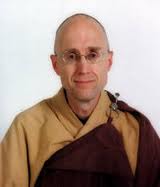
(well worth picturing multiple times)
If prostrations make us feel sick or physically upset in any way, we should not do them or at least not exceed the number we feel comfortable with. If we can only do three prostrations per day, we do them slowly and mindfully. That will be better than running through 88 or 108 in an athletic manner. A single mindful prostration exceeds in value a countless number of mindless prostrations. A young monk once asked his teacher: “When will I have performed enough prostrations?” The teacher replied: “When you have performed enough prostrations, you will know.” We are not bowing to the Buddha when we perform prostrations, we are bowing to our inner Buddha nature, our original self. There is no one “out there.” The infinite Buddha is us, always has been and always will be because there is no yesterday, no tomorrow, no today, and no us that is independent from everything else. There is no independent self, no other, no time, no space, no sun, no universe, no life, no death. We empty our cup if we believe otherwise. All phenomena that appear to be external and real are just projections of our deluded, unenlightened minds. When we wake up and see what is really going on, we will have to have a good laugh. However, we can’t experience the truth of mind alone until we have experienced the four jhanas, the four immaterial attainments, and turned the super power mindfulness thereby created to contemplation of the four foundations (focuses) of mindfulness, or impermanence, fading away, cessation and abandoning/letting go, all as set forth in the Anapanasati Sutta. As Christian Science founder Mary Baker Eddy so astutely observed, all thoughts of health and sickness, God on the one hand and self on the other, are merely “mortal thoughts,” the thoughts of the deluded. How could we, on the one hand, bow to the Buddha on the other? The concept of bowing to some external agent is a deluded thought. There are no two things in emptiness, nor is there one thing or zero things or other mental perceptions. The belief that there are two things is a mortal thought. How could there be a savior out there, separate and apart from us? Mary Baker Eddy, like the Buddha, had the insight that there are no seams in reality. So did Meister Eckhart who said: “The eye with which I see God is the same eye with which God sees me.” And there is no god in emptiness. Nor is there emptiness in emptiness. Performing prostrations also increases our sense of gratitude for the Buddhas of the past, present, and future. Here is the greatest story ever told about gratitude: In the eighteenth century, a samurai warrior was determined to bring all of Japan under his control. Assembling an army of like-minded ruffians, he attacked his first town and slaughtered the inhabitants without mercy. “When people see how ruthless I am,” he predicted, “they will stop resisting my advance and I will be the Emperor above all.” A few people escaped from the destroyed town and warned the people in the next town down the road that a warrior who lacked mercy was approaching. The people of that town fled and the warrior was quite pleased when he learned that they had done so. “My strategy of putting all who resist me to the sword is working,” he smiled. One day, however, his scouts did not make the usual report. Instead, they said: “The next town has been evacuated, Your Highness, thereby coming under your control and expanding yet further your majestic empire. However, there is one old Zen monk who declined to leave his monastery when we warned him of your approach.” The warrior was angered. “How dare an old man resist me! I will teach him a lesson.” He stormed into the monastery, saw the monk sitting on the floor in the lotus position, pulled out his sword and roared: “Don’t you know who I am?” The old monk responded by saying: “Sorry, sir, but I do not know who you are.” Brandishing his sword, the warrior said, with pride: “I am the one who could run you through, and think nothing of it.” To this the old monk responded: “Pleased to meet you. And I am the one who could be run through and think nothing of it.” This reply so astonished the warrior that he sheathed his sword and said: “To face me so fearlessly, to be so unafraid of my sword, you indeed are a better man than I am. I see that you are a monk, a holy man. Teach me about heaven and hell. I have heard of these things but I never received an education on these matters.” “I do not teach dogs or swine such as yourself,” replied the monk, without looking up. Needless to say, the warrior was incensed by that answer and quickly retrieved his sword. Trembling with anger, he raised it high over his head, the better to decapitate the monk with a single stroke. “That is hell,” said the monk. “What did you say?” inquired the warrior. “This is hell? This anger? This hatred?” “Yes,” affirmed the monk. “I see,” said the warrior. “Oh! I understand! This desire to kill, this feeling that comes with wanting to kill someone! So that’s hell! It’s such a terrible feeling! As I prepared to bring my sword down on your neck, I felt so bad! My rage made me truly miserable.” “You did teach me! I have learned what hell is! Thank you kind sir for this lesson. Thank you, Thank you!” And the old monk looked up and said: “And that’s heaven.” I first ran across that delightful (even if apocryphal) story in Zen Flesh, Zen Bones, the cite for which is Paul Reps, and Nyogen Senzaki, Zen Flesh, Zen Bones, A collection of Zen and Pre-Zen Writings.Boston: Charles E. Tuttle Co., 1957. The warrior repented of his war-loving ways, and became a disciple of the monk who could be run through and think nothing of it – legend says it was Master Hakuin. If we haven’t yet committed to memory Master Hakuin’s Chant in Praise of Zazen, let’s do it now. See Norman Waddell, Wild Ivy: The Spiritual Autobiography of Zen Master Hakuin. Boston & London: Shambhala, 2001. Master Hakuin never mentioned an encounter with a warrior in his writings so we suspect the story is apocryphal – or it involved a monk or nun other than Hakuin – but it’s still a great story. 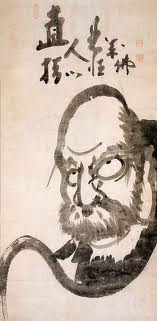
Master Hakuin (self portrait)
We have to do prostrations until we want to perform prostrations. And then we will increase our prostrations both in quantity and quality. What is there outside us? What is there we lack? Nirvana is openly shown to our eyes. This earth where we stand is the pure lotus land, and this very body the body of Buddha. There is no place to go, no thing to do, no goal to reach. Awakening is the realization that there is no one to awake, no one to fear being run through. One way to count to 108 is to recite the above 54 steps and to then perform one prostration for each line of the Heart Sutra. The Heart Sutra is a chant about emptiness, i.e., the absence of an independent self (“none are born or die”) and the concomitant interconnectedness of all sentient beings. The Heart Sutra is a nickname; the Sanskrit title of this chant is Prajna Paramita Hridaya, which translates as The Perfection Of Wisdom Chant. Prajna means wisdom. Paramita means perfect or perfection and Hridaya means a long mantra, i.e., a chant. So where does the title “Heart Sutra” come from? One source tells us that the original Prajna Paramita Sutra from which it is taken is very lengthy and the current verses were condensed from the longer sutra. These current verses are the most important phrases, i.e., the heart of the sutra. Another source says that it is a summary of other sutras such as The Diamond Sutra, The Lotus Sutra, The Avatamsaka Sutra, and so on, i.e., that it contains the heart of those sutras and thus the heart of the Buddha’s teachings. Perhaps the best source of information about The Heart Sutra and more importantly, what it teaches, is Red Pine’s commentary. In my opinion, his book is priceless. The Bodhisattva of Compassion, mentioned in the opening line of the Heart Sutra, sometimes translated as the Goddess of Mercy, is Guanyin, known in Japanese as Kanzeon or Kannon and sometimes called the Chinese Virgin Mary. Guanyin came first so Mary is more fairly called the Guanyin of the West. This beautiful lady is called Avalokitesvara in Sanskrit and was a man in India; the Chinese made him into a woman. Perhaps they felt that compassion was more womanly than manly. The “skandas” are the five aggregates that collectively form an apparent independent self. The five aggregates are: Form, feeling, thought/perception, choice/volition, and consciousness. A form or a body must exist before something can be touched to create a feeling and a feeling must exist before a thought can arise. No choice can be made until thoughts arise and there can be no consciousness without form, feeling, thought and choice. Red Pine points out the connection between the four foundations of mindfulness as taught by the Buddha and the five skandas. The first two skandas are the body and feelings which match the first two foundations of mindfulness. The third foundation of mindfulness, that of the mind, is divided into the third, fourth and fifth skandas of thought, choice, and consciousness. The fourth foundation, mindfulness of mind objects, thus becomes subsumed into the fifth skanda. The meaning of The Heart Sutra is not easily understood. It won’t make a lot of sense at first but Red Pine’s commentary is very beneficial and we highly recommend it. The truly mind-blowing, beyond profound meaning of The Heart Sutra can sink in only with months or years of repetition. The unconscious mind will eventually figure it out. After completing fifty four prostrations, we recite “The Bodhisattva of Compassion” with our fifty-fifth prostration, “from the depths of prajna wisdom” with our fifty-sixth prostration, and so on. Prajna Paramita Hridaya (Heart Of Perfect Wisdom) The Heart Sutra 1. The Bodhisattva of Compassion 2. from the depths of prajna wisdom 3. saw the emptiness of all five skandas 4. and sundered the bonds 5. that cause all suff’ring. 6. Know then: 7. Form here is only emptiness, 8. emptiness only form. 9. Form is no other than emptiness, 10. emptiness no other than form. 11. Feeling, thought and choice 12. consciousness itself 13. are the same as this. 14. Dharmas here are empty, 15. all are the primal void. 16. None are born or die. 17. Nor are they stained or pure, 18. nor do they wax or wane. 19. So in emptiness no form, 20. no feeling, thought or choice, 21. nor is there consciousness. 22. No eye, ear, nose, 23. tongue, body, mind; 24. no color, sound, smell, taste, touch, 25. or what the mind takes hold of, 26. nor even act of sensing. 27. No ignorance or end of it, 28. nor all that comes of ignorance. 29. No withering, no death, 30. no end of them. 31. Nor is there pain 32. or cause of pain 33. or cease in pain 34. or noble path to lead from pain, 35. not even wisdom to attain, 36. attainment too is emptiness. 37. So know that the Bodhisattva, 38. holding to nothing whatever 39. but dwelling in prajna wisdom, 40. is freed of delusive hindrance, 41. rid of the fear bred by it, 42. and reaches clearest nirvana. 43. All buddhas of past and present, 44. buddhas of future time 45. through faith in prajna wisdom 46. come to full enlightenment. 47. Know then the great dharani, 48. the radiant, peerless mantra, 49. the supreme, unfailing mantra, 50. the Prajna Paramita, 51. whose words allay all pain. 52. This is highest wisdom, 53. true beyond all doubt, 54. know and proclaim its truth: This complete the 108 prostrations. We conclude the prostration practice while standing as we conclude the chant: Gate, gate (gone, gone) paragate (gone beyond) parasamgate (gone completely beyond) bodhi, svaha! (enlightenment, rejoice!) We chant the sanskrit words at the end, keeping in mind the translation. The Heart Sutra is chanted daily in most monasteries and is believed to be chanted worldwide more than any other chant. We did not introduce it in the chanting practice above because it can be recited daily as the second half of the 108 prostrations. Chinese Pure Land Monks typically perform 500 prostrations per day. And thousands of Buddha Name Recitations. 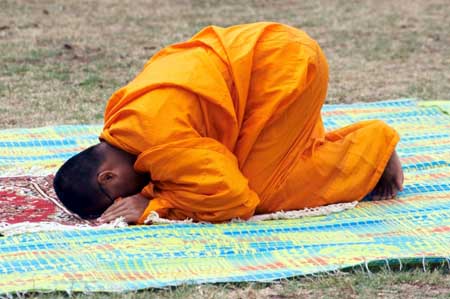
Some of us perform the above 108 prostrations in the morning and would like to repeat the practice in the evening or night. A good way to do a second set of 108 is to repeat the Taking Refuge prostrations, i.e., the first nine prostrations of the first set, followed by: Recitation of the Four Brahma Viharas: 10. Metta (loving kindness) 11. Karuna (compassion) 12. Mudita (sympathetic joy, i.e. happiness in others happiness) 13. Upekkha (equanimity) Then we recite the Six Paramitas (perfections): 14. Dana (generosity) 15. Sila (keeping the precepts) 16. Viriya (energy) 17. Ksanti (patience, tolerance) 18. Dhyana (meditation) 19. Prajna (wisdom) Followed by the Seven Factors of Enlightenment: 20. Sati (mindfulness) 21. Dhamma vicaya (investigation) 22. Viriya (energy) 23. Piti (joy) 24. Passaddhi (tranquility) 25. Samadhi (concentration) 26. Upekkha (equanimity) And the Ten Verse Kannon Sutra: 27. Kanzeon! 28. Praise to Buddha! 29. All are one with Buddha, 30. all awake to Buddha – 31. Buddha, Dharma, Sangha – 32. eternal, joyous, selfess, pure. 33. Through the day Kanzeon, 34. Through the night Kanzeon. 35. This moment arises from mind. 36. This moment itself is mind. Kanzeon is Japanese for Quan Yin (Mandarin), the goddess of mercy or Bodhisattva of Compassion as mentoned above, whose full name is Quan Shi Yin which is why the Japanese transliteration has three syllables. The final seventy two prostrations, i.e., prostrations 37-108, are reached by recitation of the Hsin Hsin Ming (Affirming Faith in Mind) which has 72 verses and which appears in the chanting section above.
Sutra Study
We recommend beginning sutra study with the Majjhima Nikaya, the middle length discourses of the Buddha, the Digha Nikaya, the longer discourses of the Buddha, the Samyutta Nikaya, the connected discourses of the Buddha, the Anguttara Nikaya, the numerical discourses of the Buddha, and the Khuddaka Nikaya. The first four works were considered to include the complete works of the Pali Canon. The Khuddaka Nikaya was added afterwards to collect additional suttas of later origin and is now a part of the Pali Canon. The five Nikayas together collectively form the Theravada Nikayas. These five Nikayas are the five divisions of the Sutta Pitaka, i.e., the Sutta basket of The Three Baskets. The Majjhima Nikaya contains one hundred fifty two suttas, each just a few pages in length, that contain virtually all of the Buddha’s teachings. The suttas are well introduced and well-footnoted by the translators, Bhikkhu Nanamoli (1905-1960) and Bhikkhu Bodhi (a Theravada monk currently practicing at the Chuang Yen monastery about an hour north of NYC).
The Satipatthana Sutta is sutta number ten in the Majjhima Nikaya. This is the sutta that teaches the Four Foundations of Mindfulness, the heart of vipassana/insight meditation. In the Theravada school, some practitioners practice vipassana (insight) meditation to the exclusion of tranquil wisdom meditation. This is known as dry insight but it is said to be as powerful as any other form of meditation and the Buddha called it the “direct path” to awakening. A good book on the Satipatthana Sutta is The Heart of Buddhist Meditation: Satipatthana: A Handbook of Mental Training Based on the Buddha’s Way of Mindfulness. Sutra/sutta study can be dull at first but the suttas gradually become more interesting as the loose ends are tied together and we begin to see the big picture. A Zen or any Buddhist practice that does not include sutra/sutta study is an incomplete practice. In the Mahavedalla Sutta, sutta study and discussion of suttas with others is listed as a requirement for Stream Entry (the first stage of the four stages of enlightenment) along with following the precepts, samatha/calmness or tranquil wisdom and vipassana/insight meditation practice. However, we have to avoid an overemphasis on sutra study. The monastics of the now extinct T’ien T’ai sect, for example, were reputed to spend so much time on sutra study that they had little time left for meditation. That is why we recommend, at the beginning, reading no more than a few pages per day. Even at that relaxed pace, a mountain of wisdom will be acquired by the serious student in just a few months. When we read the sutras with an open mind, we are listening to the Buddha. Our wisdom grows incrementally day by day. Here is a website with a comprehensive list of individual sutras. Here is a link to Dwight Goddard’s anthology entitled A Buddhist Bible. Obviously, we will never run out of Theravada suttas and Mahayana sutras to read and re-read. Many Mahayana sutras are of Chinese origin and it takes time to get used to the lofty language. However, even if they seem oddly foreign at first, they become delightful with daily reading. The average westerner will find the Mahayana sutras to be quite bizarre at first. The soaring descriptions of Buddhas and Bodhisattvas arriving to hear a sermon, complete with some pretty far out names, as well as the extraordinarily strange way of delivering the main teaching of the sutra itself will strike most people as unusual indeed. Yet, the experience of reading such sutras is not to be missed. As they are read and re-read, they work their magic. It takes a somewhat advanced practitioner to appreciate the subtle teachings of the Mahayana sutras. The Mahayana sutras presuppose that we already know the fundamentals of Buddhism and have already spent many hours in meditation. And thus we begin to understand the The Three Characteristics of Existence: Dukkha, Annica, and Anatta. However, one can see the three characteristics of existence without seeing dependent origination but dependent origination cannot be seen until the three characteristics are seen. 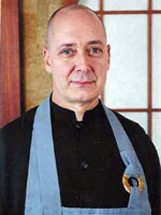
Roshi Bodhin Kjolhede, Abbot of the Rochester Zen Center
Rather than read works of mental pollution, we should read the sutras instead. Here’s what Dharma Master Hsuan Hua says about the sutras: People need air to live, and the Buddhist sutras are the true air in the atmosphere. When we study the sutras, we are breathing in fresh air. We are also taking in food for the spirit. When we cultivate according to the sutras, and tell other people about the principles found in the sutras, so that they can develop faith in the Buddhadharma, we are in effect giving fresh air to people. The sheer volume and length of the sutras and suttas may be one reason the Zen sect has historically de-emphasized sutra study. Many historians have also pointed out that the Samurai warrior class of Japan was attracted to Zen in large part for that very reason; most warriors in those days were illiterate. However, we modern Buddhist practitioners have no excuse; we can read and to shun the sutras or the suttas is to knowingly reject the teachings of the Buddha. The Theravada school rejects the Mahayana sutras as being syncretic, i.e., borrowing from non-Buddhist sources such as Chinese Taoism (Daoism). For example, as mentioned above, the Hsin Hsin Ming, one of the most prominent of all Zen Sect chants, is a Daoist (Taoist) chant. The Zen Sect itself, of course, was created when Indian Buddhism, brought to China by Bodhidharma, blended with Chinese Daoism, the indigenous “religion” of China. The Zen Sect was not brought to China from India as so many sloppy writers have announced. There was no Daoism in India so the blend of Buddhism and Daoism could not have occured before Bodhidharma arrived in China. And some scholars tell us that Bodhidharma was probably a series of Indian monks, not just one. It may well be that the only suttas uttered by the Buddha are the Theravada suttas; Zen Sect practitioners should not reject them – duh! For crying out loud, the Buddha revealed his sixteen step meditation in the Theravada suttas! But most Zen teachers continue to ignore the suttas. Some scholars also point out that the Theravada suttas as they have survived over the centuries may not be the actual words of the Buddha as well; there is evidence of tinkering. For example, many scholars point out that an enlightened being such as the Buddha would not have been so reluctant to admit women into the sangha. Those scholars say that lesser men may have put some small-minded words into the mouth of the Buddha. 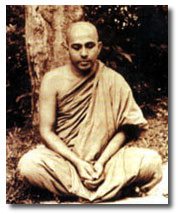
All teachers of the Buddhadharma often caution their students that the spoken words of the teachers and the written words of the Buddha are a finger that points to the moon. If you want a cat to look at the moon, you can point at the moon but the cat will look intently at your finger, especially if you wave it around. Some practitioners become attached to the words of the Buddha and they forget that the words are pointing at the moon and are not the moon itself. The Mahayana sutras evolved from the original suttas, and broke away from the prison of words that some practitioners imposed on themselves. They point at the moon using much loftier speech than the Buddha ever used, but the lofty speech, a product of Chinese culture, is still the Buddhadharma. Many scholars have argued that if the Mahayana had not arisen about a hundred years after the passing away of the Buddha, Buddhism would not have become a world religion. It would have remained a regional religion, the religion of the southeast Asian countries. The Buddhism taught by the Theravada school is authentic, although we may want to take some of it (such as the anti-women words above-mentioned) with a grain of salt. The Buddha says repeatedly throughout the suttas to test the words, not to just believe what they say. If a teaching leads to increasing wholesomeness, embrace it, said the Buddha. If a teachings leads to decreasing wholesomeness, i.e., to increasing unwholesomeness, reject it, said the Buddha. Every Buddhist should study the Theravada suttas to learn the Four Noble Truths and the Eightfold Path (which is the Fourth Noble Truth). The Tipitaka (the Three Baskets) of the Vinaya (rules of discipline), the Suttas, and the Abhidharma have been preserved by the Theravadans from the days of the Buddha and they are a treasure. But the whole of Buddhism contains the Mahayana sutras as well. 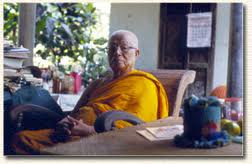
What the Buddha Taught is not a sutra, but it is probably the most-read book on Buddhism in the Western world. It has been criticized as being dry, academic and non-inspirational but it includes the basics of what the Buddha taught so it is a good book to read before beginning sutra study. The sutta pitaka (sutra basket) is the first of the three baskets (tripitaka) that collectively form the Buddhist canon. The second basket, the vinaya pitaka, is that of discipline, specifically the monastic rules to which monks and nuns must adhere when interacting with each other and members of the laity. The third basket is the abhidhamma pitaka, which is a collection of commentaries on the suttas, sub-commentaries on the commentaries, and other miscellaneous writing and poems. However, it is sometimes criticized as being too psychology-based. No amount of intellectual reasoning will allow us to experience dependent origination. When we experience the four jhanas and the four immaterial attainments, followed by the dharma realm of Nirvana, that of cessation of neither perception nor non-perception, we then experience dependent origination both forward and backward and that means Buddhahood, the first dharma realm, has been realized. (But the “I” is utterly dissolved and there is no “I” that attains Nirvana). In the Theravada suttas, Nirvana is not considered one of the dharma realms. It is not a plane of existence. The Zen Sect, because it is highly disciplined and stresses meditation more than sutta or sutra study or chanting, is considered by some Buddhists to be a radical sect. It is true that many meditation techniques are designed to make it to the top of the mountain by spiraling round and round, gradually ascending with great strain like a train gradually gaining elevation. Zen, however, has been compared to a rocket that blasts off and goes straight up, bursting through the clouds into the sky. One of the great shortcomings of American Zen, however, is its lack of emphasis on following precepts and engaging in sutta study. Buddhists who study the suttas to the exclusion of meditation are making a mistake; meditation must be practiced. However, Buddhists who meditate without sutta study are also missing the boat. It is futile to meditate in total ignorance of the suttas. 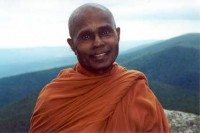
Some teachers even teach their students to ignore meditation for years, teaching them to concentrate on sutra study. The theory is that by the time the student begins meditation, the amount of time spent in meditation will be nominal because the student’s mind will be close to enlightenment thanks to the effects of the sutra study. Enlightenment doesn’t happen magically. The conditions have to be ripe. Those who study without meditation and those who meditate without study have not created the conditions that allow awakening to occur. Daily sutta/sutra reading, preferably near the end of the day, will become second nature. In our previous lives, we skipped sutta/sutra study. That’s why we have to do it now. We failed to awaken to Buddhahood then because we deemed such practice unimportant. Now we know better. The Mahayana sutras include The Diamond Sutra, The Surangama Sutra, The Lotus Sutra, The Avatamsaka Sutra (chapter 26 of which forms the basis for the ox-herding pictures), The Lankavatara Sutra, The Heart Sutra, and many others. The Mahayana texts represent the evolution of the original texts. The Theravada school rejects the Mahayana sutras, but almost every talk I’ve heard given by a Theravada teacher includes at least one Zen teaching. The schools are not really that far apart. 
In addition to sutta and sutra reading, we also recommend How the Swans Came to the Lake and The Buddha and the Sahibs. These books have no Buddhist teachings but tell the story of how Buddhism came to the West. Despite similar objectives, the two books include little overlap. The former introduces us to many of the major Buddhist organizations that are active today and the latter tells the amazing story of how British officials uncovered India’s forgotten Buddhist past. Koan study requires close teacher/student collaboration. However, an advanced practitioner can benefit from reading koan collections such as The Blue Cliff Record, The Mumonkan, (The Gateless Gate), The Book of Serenity, (Shoyoroku), The Shobogenzo, (Treasury of the True Dharma Eye), and books such as Sitting With Koans by John Daido Loori. Cultivating Wholesome States
Cultivating Wholesome States
“Therefore, bhikkus, abandon what is unwholesome and devote yourselves to wholesome states, for that is how you will come to growth, increase, and fulfilment in this Dhamma and Discipline.”
-The Buddha, The Kakacupama Sutta
During sutra study, we will encounter the Six Paramitas (Perfections) as well as the Four Brahma Viharas and the Seven Factors of Enlightenment. The Six Paramitas are: 1. Giving or generosity (a direct counteraction to greed); 2. Precepts/morality (practicing all ten precepts to perfection); 3. Patience (which may work as a forbearance of greed); 4. Vigor or diligence (emphasizing the importance of Seeking The Ox); 5. Concentration or mindfulness (the foundation of which is Present Moment Awareness, followed by Silent Present Moment Awareness); and 6. Wisdom (Understanding the Four Noble Truths). These are six wholesome states or practices to be cultivated. Red Pine points out that items 2, 5, and 6 are the morality (right speech, action and livelihood), meditation (right effort, right mindfulness and right concentration) and wisdom (right view and right thought), respectively, of the eightfold path. The Mahayana put generosity first, and inserted patience and diligence after morality to arrive at the six perfections. The Four Brahma Viharas are: 1. Good will/loving kindness (metta); 2. Compassion (karuna); 3. Altruistic/Sympathetic Joy (mudita); and 4. Equanimity (upekkha). These are four wholesome states to be cultivated. The seven factors of enlightenment are: 1. Mindfulness (sati) 2. Keen investigation of the dhamma (dhammavicaya) 3. Energy (viriya) 4. Rapture or happiness (piti) 5. Calm (tranquility) (passaddhi) 6. Concentration (samadhi) 7. Equanimity (upekkha) They are not the seven factors of feeling good. They are the seven factors of anuttara samyak sambodhi, perfect unexcelled Buddhahood. They provide seven more wholesome states to be cultivated.
If we have not practiced zazen, sitting meditation, we know nothing about Zen, regardless of how many Buddhist books we’ve read and Buddhist websites we’ve visited. We are like the scientist who studies sugar but never tastes it. Or the scholar who wrote books on Catholicism but was not a Catholic. When asked why he had never become a Catholic even though he was a world-class scholar on the religion, he said: “You can study a disease without catching it.” A funny line. Obviously, however, he had no idea what Catholicism is all about because he had never experienced it. To empty the cup means to drop opinions, to admit that we know nothing. As Socrates said: “The only true wisdom is in knowing you know nothing.” Socrates was no Buddha but he was close. He famously counseled his students to “Know Thyself.” As Hyon Gak Sunim says, Zen is all about answering the question: Who are you?
We cultivate wholesome states by practicing the six paramitas, the four brahma viharas, and the seven factors of enlightenment. We also cultivate wholesome states by practicing mindfulness of the body, of feelings, of the mind and mind objects. Leaning toward pleasure and away from pain is evidence of Wrong Thought. Right Thought walks the middle way between pursuing pleasure and avoiding pain. Right Thought leads to the realization that pleasure is nothing but a temporary end to pain and it is always followed by the resumption of pain, which is followed by more pleasure, and so on, endlessly.
Advanced Physical Training
When we attend a sesshin, we will begin the day with a fast-paced morning kinhin. Although usually only about ten minutes in length, the pace is too fast for the obese or physically unfit. We will then have a drink of water and go the meditation hall, or zendo, for the first sitting of the day.
So we prepare for the fast kinhin in our daily practice at home. In Advanced Zen, after completing our Beginning Zen kinhin and our warm-up exercises, we take a brisk walk. We have a glass of water afterwards and go to our private meditation hall as soon as we finish our morning walk. An invigorating thirty minute walk is recommended. Zen practice requires vigor. Only a healthy, vibrant body can sit perfectly still. The cultivation of vigor or energy is also the fourth factor of the Seven Factors of Enlightenment. The energy referred to in the Seven Factors, however, is a different quality of energy. It arises from sustained meditation, and primarily through practice of the Four Foundations of Mindfulness. We therefore walk or jog every morning after warming up using the Eight Form Moving Meditation to help us prepare for the retreats that we will be attending, and to develop and maintain the fitness level we need to enable us to sit motionless during our daily meditation practice. Physical fitness is an important part of Zen practice. The length and pace of the morning walk is up to us. Thirty minutes is probably an effective minimum. An hour feels even better. The athletic nature of a walk or jog is secondary; the primary purpose is to develop the habit of walking or jogging in the morning after performing the beginning and intermediate zen warm-up practices. As advanced practitioners who by now have read and studied Mindfulness, Bliss and Beyond, we know that the first two of the four jhanas are recognized by feelings of intense joy at the first jhana and by feelings of a more stable and serene happiness at the second jhana. No amount of advanced physical training will take us into the first and second jhanas because the pleasant feelings we generate fall far short of the intense experience of those two jhana states. Still, it is instructive to note that as we insulate ourselves from falling into the tenth dharma realm, we are forming a foundation for the experience of the first two jhanas.
Helpings Others In Their Practice
When we have cultivated happiness, loving kindness, generosity, the precepts, learned the chants, performed Buddha Name Recitation, when we have taken refuge and performed prostrations, studied the most fundamental sutras, and have established a yaza practice, we are ready to start helping others in their practice. When we sit with a group we are performing a bodhisattva service. Everyone who participates in a group sitting supports the others. However, sitting with a group for a couple of hours once a week is the minimum service we can provide. The Buddha said that from time to time, we need to sit for an extended period of time. Near the end of the Anapanasati Sutta, he famously mentioned seven days of continuous meditation as the period of time required to enter the stream. Since that time, millions of people have attended seven day retreats, known in the States by the Japanese name sesshin. Venerable Ajahn Brahm says that the reason most of those people did not awaken was because they did not follow the Buddha’s instruction to “put mindfulness in front of you” as an integral part of each sitting. So the importance of Present Moment Awareness and Silent Present Moment Awareness cannot be over-emphasized. It is of paramount, primary and fundamental importance. However, people who attend lengthy sesshins early in their practice usually quit practicing altogether; I have known several people who started off with a four day sesshin, never to be heard from again. A strong foundation should be in place before a lengthy sesshin is attempted. We recommend starting with a home sitting practice, then joining a group (while continuing the daily home practice, of course), and then moving on to single day sittings (zazenkai) or weekend sittings. After a few weekend sesshins, we will be ready for a four day sesshin and after a few of those we can attend a full seven day sesshin. Yaza is encouraged at sesshins, but we probably should not attempt yaza during our first sesshin unless we have a teacher who encourages us to stay up late for additional practice. Many of us are ready to collapse after a sesshin day, especially during the first few sesshins. I have attended twenty six four day sesshins and have never attended a seven day one. As a registered patent attorney workaholic, whenever I have seven days off I visit my sister in Oahu. But at least I spend some time with meditation groups there! Sesshin attendees should have a full, well-rounded practice. When we have developed a strong morning and yaza practice at home, and have attended multiple one day and weekend sesshins, then we are at least ready for a four day sesshin. Sesshin is Japanese for “collecting the heart.” It is often called Zen boot camp because it is rigorous. In the states, sesshin typically begins at 5:00 AM and continues until 9:30 PM for several days. A four day sesshin will begin on a Wednesday evening, for example, and end on the following Sunday afternoon. On Wednesday evening, everyone gathers for an orientation meeting where the various rules of sesshin are reviewed. The orientation is followed by a round or two of sitting, often accompanied by a brief tea ceremony. Here is a typical four day sesshin schedule. We can try a day or two of following the schedule at home before attending a real sesshin. Thursday morning begins with a wake-up bell and everyone gathers for a brisk morning walk at 5:15. Known by the Japanese term “kinhin” mentioned earlier, this is a fast-paced single file walk through the grounds of the sesshin location. If we can walk quickly for ten or fifteen minutes, we will have no problem keeping up. We can train for such a walk a few weeks or maybe even a few months before attending a sesshin. At 5:30 AM after the morning kinhin, we drink some water and enter the zendo for one round of sitting, typically 35 minutes. Then we can expect a chanting period where the Heart Sutra and the Hsin Hsin Ming (Affirming Faith in Mind) are chanted, along with one or two other chants. Chanting is typically followed by two 35 minute rounds of sitting, spaced apart by six or seven minutes of single file kinhin, and then it’s time for breakfast. The meal chants are included in the Rochester Zen Center chant book. About the only times our hands are not in the kinhin position is when leaving the zendo for a formal meal. Everyone files out of the zendo in single file, as during a kinhin, but the hands are in gassho (palm-to-palm, the “praying hands posture,” with the thumbs centered on the chest and the elbows bent just as in kinhin) instead of the kinhin position. A work period of about forty five (45) minutes follows breakfast. We will be assigned a job such as sweeping, vacuuming, mopping, etc. The work period is followed by an hour of rest where we are free to sleep. The next round of sitting is followed by a live Teisho, a talk by an ordained Zen teacher, and the talk is followed by another round of sitting and an informal (no chanting) lunch. Another rest period follows lunch. Next comes three rounds of sitting, separated only by kinhins. Dokusan is typically offered. Then there is an exercise period where an advanced student will lead stretching or yoga exercises, followed by an extended kinhin, another sitting, and supper.
Guang Ming Temple, Orlando, Florida
Supper is followed by the final rest period of the day and the day ends with three more sittings after that rest period. Dokusan is usually offered during these last three rounds of sitting as well. The final sitting ends around 9:30 PM. However, many teachers urge sesshin participants to stay up and practice as long as they can, foregoing sleep. That’s yaza practice. Snacks are available for those who meditate throughout the night. Unless we have become a very advanced practitioner, we will probably need all the sleep we can get to be ready for the next day. What does a Buddha do? A Buddha sits in meditation. Morning and evening. The meditation doesn’t end when the bell rings and we stand up to bow and begin kinhin. Nor does it end when the sesshin ends and we drive home or to a post-sesshin meal at a restaurant. The whole point of Zen practice is to remain mindful of the Buddhadharma at all times. We stay with the koan or the breath, with the practice, even when we leave the cushion. Especially when we leave the cushion. The time spent outside of formal meditation is more important than the time spent in formal meditation because that is when we manifest the practice. If we have honestly followed this program up to this point, we will understand what is meant by: “Sesshin never ends.” We meditate in the morning, we meditate in the night, and throughout the day we walk in Zen. We should attend as many sesshins as we can. By doing so, we are helping others in their practice, and, obviously, they are helping us. We can never practice alone as intensely as we practice with others. Some sesshins are tougher than others. At the City of Ten Thousand Buddhas, the first sitting of the day is 2:30 AM and the day ends at midnight. But even an “easy” 5:30 AM to 9:30 PM four day sesshin can be quite a challenge. At Japan’s Eiheiji Temple, founded by Master Dogen, sesshins are very strict, as is daily life at the temple. See Eat Sleep Sit. If there is no sitting group near us, we can start one by using Meetup.com or Facebook and meeting at a place like Starbuck’s or Panera Bread, for example, until the group is big enough to rent or buy a practice center. We don’t recommend meeting at full service restaurants; donut or coffee shops are best. The Meetup group continues to meet so that new members are continually welcomed into the practice center. Sangha is a Sanskrit word defined as a community of monks or nuns. In the U.S., we use the word loosely to include a sitting group of lay people. Places like Starbuck’s and Panera Bread are perfect spots for a Meetup group but of course such locations are not suitable for the practice of sitting meditation. The Meetup group can discuss practice but the formation of a sangha requires a meeting place where practice is appropriate. Buddhism is changed by every culture that practices it. In the States, Buddhism has changed in three major ways from Asian Buddhism. First, Americans have no Buddhist heritage and are not concerned with the Asian division of Buddhism into Northern School Mahayana practiced in China, Japan, Korea, Mongolia, Tibet and most of Viet Nam and Southern School Theravada practiced in Sri Lanka, Burma, Thailand, Cambodia, Laos and parts of Viet Nam along the Cambodian border. The division of Buddhism in Asia into two major schools was based primarily upon geographical separation and cultural differences. In the States, Mahayana and Theravada groups attend each other’s events and individuals move freely between the groups. A good sitting group, in my opinion, welcomes teachers from all traditions and avoids connection to a particular teacher who bars other teachers from the premises and wants to control even trivial matters. Ch’an/Zen Master Hsuan Hua has worked in profound ways with the Theravada community, even to the point of donating land for use as a monastery. He once remarked that he had practiced in previous lifetimes with Ajahn Sumedo. Secondly, Buddhism in the States is primarily a lay movement. There are very few people who qualify for the title Sensei or Roshi; the vast majority of practitioners are lay people. In Asia, few lay people who self-identify as Buddhists practice daily meditation and Buddhism is known primarily as a monastic practice. However, at least a few American Buddhists are working to establish monastaries in the U.S. When in Japan on business, I usually mention to my Japanese counterparts that I enjoy visiting and meditating in temples (few monasteries are equipped for visitors). When I tell them I meditate daily at home and that most of my friends do the same thing, even though none of us are monastics, they are simply flabbergasted. “Why, why?” they ask. Then they explain that it is the job of monks and nuns to meditate and to dedicate the merit thereby gained to lay people. Therefore, lay people do not need to meditate and if one does meditate as a lay person, it is as if they do not trust the monastic community to do its job.
Thirdly, men and women practice together in the States. Asian Buddhism is primarily segregated due to its monastic nature. So we help others in their practice by forming sitting groups if no local group exists. We also form a new sitting group if the local group is on a mission to convert everyone to their way of practice or controlled by a domineering teacher who bans other Buddhist teachers from his or her sangha.
Stream Entry
Seeking the Ox requires that we persist in the practice even when we become discouraged. Buddhist scholars have commented that Seeking the Ox doesn’t begin until the urge to give up has been overcome. And that most people give up. However, if we persist in the Beginning Zen practices every day for a long time, we are at least seeking the ox. If we can keep our daily practice schedule, perhaps for multiple lifetimes, we will attain Buddhahood. But even the Buddha continued practicing after his great awakening. And realizing Buddhahood requires a pure mind, not a mind that is quite pure. Most of us have minds that are too defiled to perform all ten of these steps to perfection. However, with sustained practice, awakening can happen. How well we cultivate wholesome states will determine whether and when awakening occurs. Fail to follow the precepts or hold the Buddhadharma in contempt and we can kiss enlightenment goodbye. But cultivate wholesome states all day long, not just when on the cushion, and “you will come to growth, increase, and fulfilment in this Dhamma and Discipline.” The classic explanation of Seeking the Ox refers to the difficulties a beginner experiences if he or she perseveres with the practice. Most beginners never reach this point. They develop pains from sitting and they quit. They never seek the ox. To seek the Ox means to persevere when it seems that no progress is being made. Right when we decide to quit, we begin seeking the ox if we don’t. We have not reached even the first jhana at this point, of course. Instead of being awash in bliss, we are more awash in physical pain that accompanies long hours of sitting. When the going gets tough, the tough persevere and start seeking the ox. When we begin a meditation practice, we are told to return to the practice whenever we start daydreaming. The same applies to all of Zen practice. When we reach a point beyond which it seems we cannot transcend, we return to step one, cultivating happiness and mindfulness through Present Moment Awareness to transcend the tenth dharma realm. We then move on to step two, practicing loving kindness meditation, transcending the ninth dharma realm. We cultivate happiness and loving kindness and generosity through Silent Present Moment Awareness and follow the sixteen steps of Tranquil Wisdom meditation every day, twice a day, until one day the bottom of the bucket drops out and we reach the source. The final step of Returning To The Marketplace is then the easiest step of all; it comes naturally. One for whom the bottom has dropped out will naturally become a teacher in order to fulfill the ancient vow of liberating all sentient beings. We seek the ox, find its footprints, glimpse the ox, catch it, tame it, ride it home, and forget it. Then we forget the self, reach the source and return to the marketplace. And if our practice is authentic, we repeat those ten steps until the practice cultivates itself without beginning and without end. Although we don’t practice to get benefits, by patiently working on each step of this program, those with whom we come into contact may reap the benefits of our practice. One cannot follow the steps outlined here without becoming more kind to people, animals, insects, and the non-sentient world. We will naturally find ourselves becoming more environmentally conscious as well as awakening begins to manifest itself.
Entrance Gate City of Ten Thousand Buddhas, Ukiah, California
Those of us who go through this How To Practice Zen course many times, until it becomes second nature to practice all ten steps every day, and to attend sesshins whenever we can, do not become enlightened teachers by doing so. Again, we are merely creating the conditions within which awakening may occur. In the Rinzai tradition, we must be tested by a sanctioned teacher before our awakening can be confirmed. There are small awakenings, large awakenings, and an infinite degree of awakenings therebetween. What one may think is a major awakening experience may actually be quite small. As beginners, we do not qualify as teachers. But we can practice Zen every day and encourage others to do the same by introducing them to these ten easy steps. We can refer others to this website, for example. Sharing the Buddhadharma with others is also a form of giving, the first of the six perfections (paramitas) practiced by Buddhas-to-be (Bodhisattvas). Those who have persisted in this course until it becomes second nature are qualified to share this course with others. The Zen sect of Buddhism traces its origins to a story that, most admit, probably never happened. The Buddha stood before a multitude of monks who had assembled at the Vulture Peak in India to hear him speak. Instead of speaking, he held up a Golden Lotus. Of all the monks present, only Mahakashapa got it. He smiled, the Buddha handed him the flower, and the sermon was over. The Buddha had transmitted the Buddha Dharma to Mahakashapa without words and Zen became known as the teaching that does not rely upon words. A lovely story, but it doesn’t appear in the Pali canon so it is probably apocryphal. The Nichiren sect really hates the story, saying it was designed to prevent people from studying the sutras, specifically The Lotus Sutra. But it makes an important point, that not even an avalanche of words can convey the deepest of meanings. The perfect Zen website is the one that was never uploaded. The most beautiful music is silence. The most enlightened words are no words at all. We see the outside world as a huge collection of diverse objects and we see our inside world as the subject that perceives those objects. But the self we think we know is just another object. As we detach from our fascination with objects and draw deeper into our subjective self by the dint of persistent practice, we realize that the objects were just projections of our own minds. And that includes our view of our selves. When the dichotomy of inside/outside falls away, both are discovered to be empty and our Buddha nature is uncovered. We then realize that it was there all along, and that it was not created by our practice. But just as the wind blows away clouds to reveal the sun that was there all along, the wind of practice blows away delusions to reveal the Buddha nature that was there all along. Buddha nature does not belong to Buddhists. It could just as well be called Original nature. Buddhist teachers of old called it Your Face Before Your Parents Were Born. After all, our Buddha nature was there long before our parents were born. Time has no beginning or end and no one owns it and that is true of Buddha nature as well. As soon as we try to describe what Zen is, we have stumbled past it. But perhaps we have to stumble past it at least a few times just to realize what we have done – unleashed a cavalcade of words and thoughts, stumbling past enlightenment while as clueless as Wily E. Coyote contemplating a burning fuse (Thank you Dan Ruth). As we follow the steps of this course on a daily basis, perhaps we will become less clueless.
We promised on the Home page to reveal the meaning of: “What is the deepest wisdom of Buddhism?” Answer: “The cypress tree in the courtyard!” (Or “vast emptiness.”) Using our intellect, the answer is: The tree really is demonstrating the deepest wisdom of Buddhism. The tree is practicing Silent Present Moment Awareness. While standing by the Still Forest Pool. Perhaps it is in the jhanas, the immaterial attainments, or Nirvana. If it is chopped down, it will fall over, without complaint, without clinging to what used to be. As it lies on its side, decaying into the forest, or hauled off to a lumberyard to be made into kitchen cabinets, it stays in Silent Present Moment Awareness by the Still Forest Pool, in Nirvana, not preferring one moment over another. It is always now, and now is always It. Try giving that intellectual answer to your Sensei at dokusan and then observe the flight path of your body as you are booted from the dokusan room. The real answer is: The meaning is unfigureoutable by thinking with a discriminating brain. We cannot think or reason our way into Nirvana. We practice until we realize that things are things because of mind and mind is mind because of things. And then we laugh at how stupid we were to think that objective things were observed by a subjective mind when in fact there are no two things, i.e., no object, no subject. The human dharma realm! What was that all about? If we have worked hard to develop super power mindfulness and turned that super power mindfulness to the koan and have penetrated it until we see the deepest wisdom of Buddhism, our Sensei will know we have passed the koan and not a word will be spoken. But he or she might still give us a swift kick in the butt to send us out of the dokusan room, just for the fun of it. May we all enter the stream! 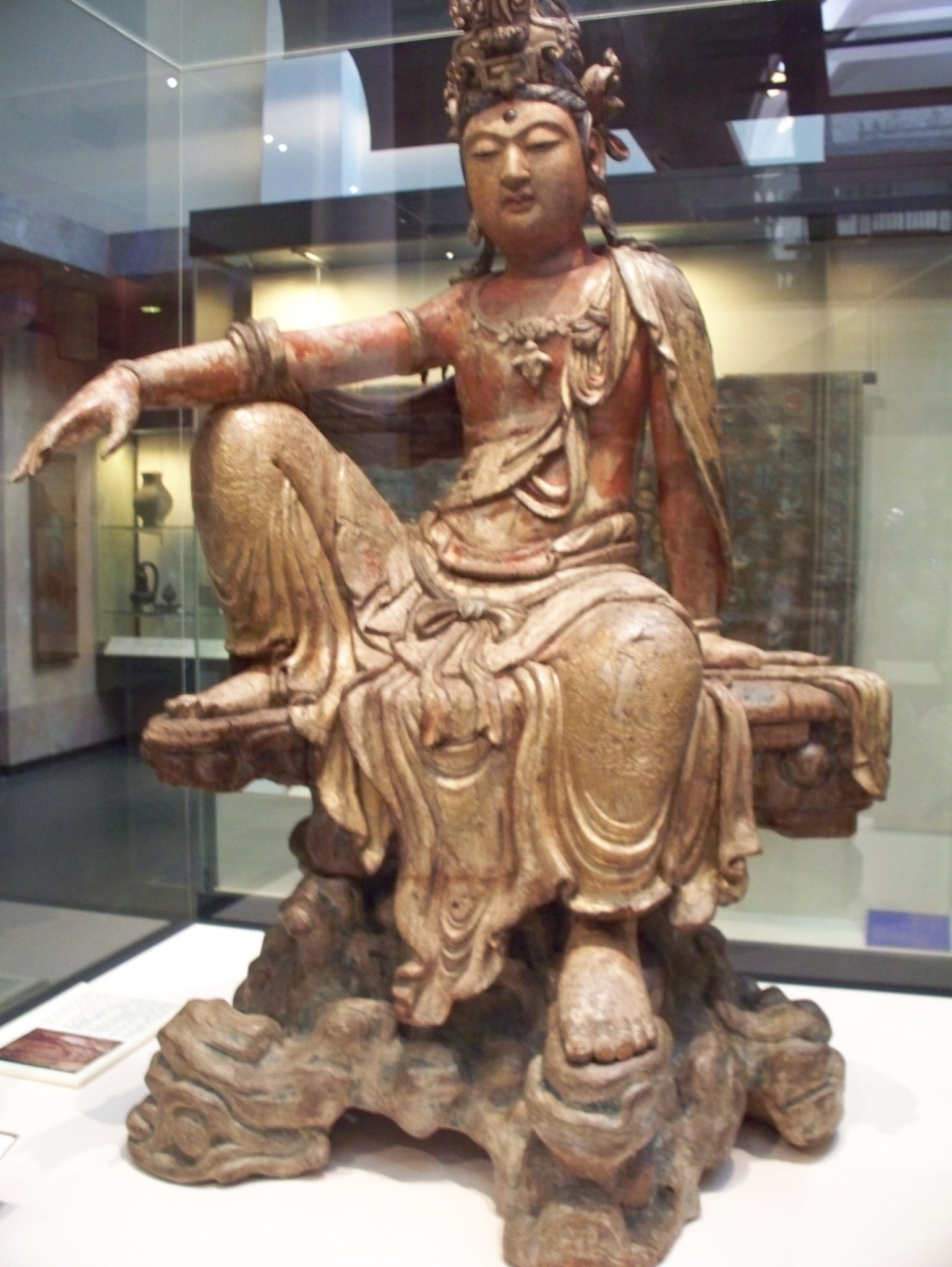
Quan Yin Bodhisattva
